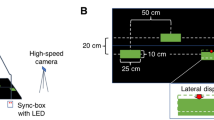Summary
The purpose of this electromyographic study was to examine the effects of age on lower limb muscle response characteristics during reaction tasks of varying complexity when standing and walking. Ten young (mean age 22 years) and ten elderly (mean age 68 years) women participated in the investigation. No differences between groups were recorded in muscle activation times (MAT) in response to a visual light directional stimulus (LDS) during all standing reaction tasks. All the women required a longer period of time to respond to LDS when walking than standing. Completion of complex walking reaction tasks produced significantly longer (P<0.001) MAT in all subjects than the more simple walking reaction tasks. Delays in neuromuscular response were significantly greater (P<0.05) in the older women as the complexity of the walking reaction task increased. Movement behaviour of subjects during the walking reaction trials suggested that relatively greater demands were placed on the neuromuscular systems of the elderly during those tasks of greatest complexity. It was postulated that these movements were directed more at compensating for a reduced neuromuscular ability to control efficiently balance homeostasis. The results of this study provide further support for the hypothesis that delays in the central processing of information during reaction tasks may occur with ageing.
Similar content being viewed by others
References
Bouisset S, Zattara M (1987) Biomechanical study of the programming of anticipatory postural adjustments associated with voluntary movements. J Biomech 8:735–742
Campbell MJ, McComas AJ, Petito F (1973) Physiological changes in ageing muscles. J Neurol Neurosurg Psychiatry 36:174–182
Chandler JM, Duncan PW, Studensky SA (1990) Balance performance on the postural stress test. Phys Ther 70:410–415
Ermini M (1978) Ageing changes in mammalian skeletal muscle. Gerontologist 22:301–316
Falduto LL, Baron A (1986) Age-related effects of practice and task complexity on card sorting. J Gerontol 45:659–661
Fischmann MG (1984) Programming time as a function of number of movements parts and changes in movement direction. J Mot Behav 16:405–423
Gabell A, Nayak USL (1984) The effect of age on variability of gait. J Gerontol 39:662–666
Horak FB, Diener HC, Nashner LM (1989) Influence of central set on human postural responses. J Neurophys 62:841–853
James B, Parker AW (1986) Comparison of gait kinematics at three velocities in men and women in the third and eighth decades. J Anat 149:265
Larsson L, Sjoedin B, Karlsson J (1978) Histochemical and biochemical changes in human skeletal muscle with age in sedentary males, age 22–65 years. Acta Physiol Scand 103:31–39
Light LE (1990) Information processing for motor performance in aging adults. Phys Ther 70:820–826
Maki BE, Holiday PJ, Fernie GR (1990) Aging and postural control. A comparison of spontaneous-and-induced-sway balance tests. J Am Geriatr Soc 38:1–9
Manchester D, Woollacott M, Zederbauer-Hylton N, Marin O (1989) Visual, vestibular and somatosensory contributions to balance control in the older adult. J Gerontol 44:M118–127
Murray MP, Kory RC, Clarkson BH (1969) Walking patterns in healthy old men. J Gerontol 24:169–178
Nashner MN (1980) Phase-dependent organisation of postural adjustments associated with arm movements while walking. J Neurophys 55:1382–1394
Rabbitt PMA, Jordan TC (1977) Response times to stimuli of increasing complexity as a function of ageing. Br J Psychiatry 68:189–201
Ring C, Nayak USL, Isaacs B (1988) Balance function in elderly people who have and who have not fallen. Arch Phys Med Rehabil 68:261–264
Roberts BL (1990) Effects of walking on reaction and movement times among elders. Percept Mot Skills 71:131–140
Sheldon JH (1960) On the natural history of falls in old age. BMJ 11:1685–1690
Stelmach GE, Amrhein PC, Goggin NL (1988) Age differences in bimanual coordination. J Gerontol 43:18–23
Stelmach GE, Phillips J, Di Fabio RP, Teasdale N (1989) Age, functional postural reflexes, and voluntary sway. J Gerontol 44:13100–106
Sudarsky L (1990) Geriatrics: gait disorders in the elderly. A review. New Eng J Med 322:1441–1446
Tinetti ME, Ginter SF, Speechly M, Ginter F (1986) Risk factors for falls among elderly persons living in the community. New Eng J Med 319:1701–1707
Vlahov D, Myers AH, Al-Ibrahims MS (1990) Epidemiology of falls among patients in a rehabilitation hospital. Arch Phys Med Rehabil 71:8–12
Winter DA (1987) Sagittal plane balance and posture in human Walking. IEEE Eng Med Biol, Sept: 8–11
Winter DA, Patla AE, Frank JS, Walt SE (1990) Biomechanical walking pattern changes in the fit and healthy adult. Phys Ther 70:340–347
Wolfson LL, Whipple R, Amerman P, Kleinberg MSN (1986) Stressing the postural response. J Am Geriatr Soc 34:845–850
Zattara M, Bouisset S (1986) Chronometric analysis of the posturo-kinetic programming of voluntary movement. J Mot Behav 18:215–223
Author information
Authors and Affiliations
Rights and permissions
About this article
Cite this article
Lassau-Wrayl, E.R., Parker, A.W. Neuromuscular responses of elderly women to tasks of increasing complexity imposed during walking. Europ. J. Appl. Physiol. 67, 476–480 (1993). https://doi.org/10.1007/BF00376466
Accepted:
Issue Date:
DOI: https://doi.org/10.1007/BF00376466




